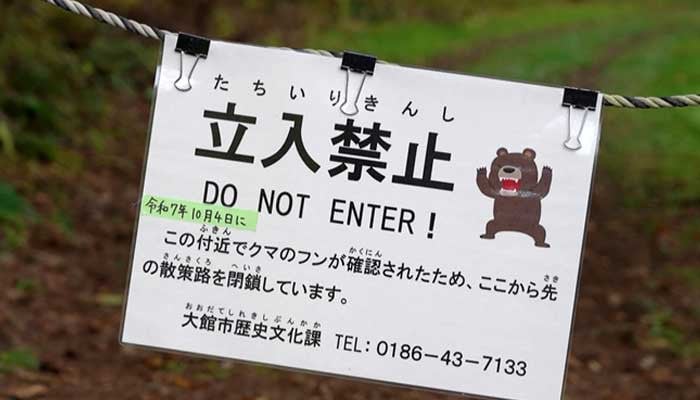
This screen grab taken from AFPTV video footage filmed on October 25, 2025 shows a "Do not enter" safety sign related to bears near a forested area in Akita Prefecture. — AFP
#Bear #fear #grips #Japan #record #fatalities #attacks #April
Kita-Akita: Fear has gripped northern Japan and locals have resorted to tying bells to their backpacks in hopes of making noise, while signs warn people to be vigilant.
The animals have killed 13 people across the country since April, with a steady stream of reports of them entering homes, roaming near schools and running amok in supermarkets.
Keiji Manatoya from Akita knows it all too well — a bear jumped out of her garage, pinned her to the ground and sank its teeth into her face in 2023.
“I was thinking: ‘I die like this’,” said Minatoya, 68, who managed to escape and take shelter inside his house.
The government is now scrambling to deal with a surge in attacks, which scientists say is being driven by a booming bear population combined with this year’s poor acorn harvest, leaving some mountains “overcrowded” with hungry bears.
Troops have been deployed to provide logistical support for trapping and hunting the bears, while riot police will be allowed to use rifles to shoot the animals, which can weigh half a ton and outrun a human.
The victims include a 67-year-old man in the neighboring region of Akita, whose body was found outside his home, with animal bite marks and scars.
Hunters were called to the scene and a bear was shot near the house.
Also in Iwate, a 60-year-old man is believed to have been attacked while cleaning an outdoor bath at a remote hot spring resort. His body was discovered in a nearby forest.
The number of injuries is also set to be a record, with more than 100 people in the six months since September, official figures show.
The bear population doubled
A bigger problem, experts say, is the expanding bear population, which is growing rapidly due to an abundance of food — including acorns, deer and squirrels — under the influence of a warming climate.
According to a recent government report, Japan’s brown bear population has doubled in three decades, and is now around 12,000, while the number of Asian black bears on the country’s main island of Hanshu has climbed to 42,000.
Some mountains have become “overcrowded,” according to Nowaki Ohnishi, a researcher at the Forestry and Forest Products Research Institute.
“Simply put, the size of the bear population has outgrown the capacity of the mountains to hold them,” he said.
Although rising temperatures have led to frequent bumper crops of acorns, the nuts still produce good and bad harvests every two to five years as part of their normal crop cycle.
This year, as well as in 2023 – the year Minatoya was attacked – is a poor supply.
Shinsuke Kwek, a professor at Tokyo University of Agriculture and Technology, said that while most bears still live in the mountains, recent bad harvests have led some – along with their cubs – to wander into cities in search of food.
With exposure to humans, cubs in particular become less fearful and develop a taste for farm produce and common fruits such as persimmons, Koike added.
Stable rural populations due to chronically low birthrates and young people moving to cities have also reduced the human presence on forests and mountain edges, blurring the traditional boundaries between people and bears.
“Bear habitats become closer to human habitats in 2023,” Ohnishi said. “This year, they’re going one step further because they’re starting where they left off.”
‘Complete Cooling’
Hajime Naka, a professor of emergency and critical medicine at Akita University Hospital, said the bear’s repeated stares made him feel like he was “living inside […] A Safari Park for Bears”.
The doctor, who has treated bear injuries for three decades, said the nature of injuries is changing as bears become less fearful of humans.
In encounters years ago, a startled bear might have hit a human in the face before running away, but now “they charge at you from about 10 to 10 meters and then jump on you”.
Without targeted intervention, he said, he expects bears to be injured and spread to other parts of the nation, adding: “We’re looking at a catastrophe.”
Researcher Onashi said “total cooling” to reduce bear numbers is the only effective way to reduce the risk to local people.
Last year the government listed bears as subject to population controls, reversing protections that had helped the bear thrive.
But rural resources are thin and the number of hunters is less than half of what it was in 1980.
As of 2020, the latest figures available, there were around 220,000, mostly in their 60s or older.
Japan intercepted more than 9,000 bears in 2023-2024, and more than 4,200 between April and September this year. Akita alone has done more than a thousand so far.
In the near future, Japan’s worries should ease, if only temporarily.
Experts Quick and Ohnishi said hibernation patterns have not shifted and bears will soon hibernate.






